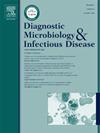肺炎球菌表面蛋白作为下一代疫苗的靶标:应对血清型变异的挑战
IF 2.1
4区 医学
Q3 INFECTIOUS DISEASES
Diagnostic microbiology and infectious disease
Pub Date : 2025-04-28
DOI:10.1016/j.diagmicrobio.2025.116870
引用次数: 0
摘要
肺炎链球菌是一种主要的全球性病原体,可引起显著的发病率和死亡率,特别是在儿童、老年人和免疫功能低下人群中。虽然肺炎球菌结合疫苗(PCVs)已经成功地减少了侵袭性肺炎球菌疾病(IPD),但诸如血清型替代和非封装菌株等挑战需要血清型独立的疫苗策略。肺炎球菌表面蛋白,包括溶肺素(Ply)、胆碱结合蛋白(CBPs)和组氨酸三联体蛋白(pht),由于其保守的性质和在粘附、免疫逃避和生物膜形成中的作用,代表了有希望的通用疫苗靶点。蛋白质工程方面的进展,如解毒的Ply衍生物和包含PhtD和PspA的多价配方,在临床前研究中显示出潜力。包括反向疫苗学和细胞外囊泡平台在内的新技术进一步加速了创新。本文综述了肺炎球菌表面蛋白研究的最新进展,强调了它们在解决pcv局限性和减轻抗生素耐药肺炎球菌菌株方面的潜力,代表了全球肺炎球菌疾病预防的一种变革性方法。本文章由计算机程序翻译,如有差异,请以英文原文为准。
Pneumococcal surface proteins as targets for next-generation vaccines: Addressing the challenges of serotype variation
Streptococcus pneumoniae is a major global pathogen causing significant morbidity and mortality, particularly among children, the elderly, and immunocompromised populations. While pneumococcal conjugate vaccines (PCVs) have successfully reduced invasive pneumococcal disease (IPD), challenges such as serotype replacement and non-encapsulated strains necessitate serotype-independent vaccine strategies. Pneumococcal surface proteins, including pneumolysin (Ply), choline-binding proteins (CBPs), and histidine triad proteins (PHTs), represent promising universal vaccine targets due to their conserved nature and roles in adhesion, immune evasion, and biofilm formation. Advances in protein engineering, such as detoxified Ply derivatives and multivalent formulations incorporating PhtD and PspA, demonstrate potential in preclinical studies. Novel technologies, including reverse vaccinology and extracellular vesicle-based platforms, further accelerate innovation. This review highlights recent progress in pneumococcal surface protein research, emphasizing their potential to address the limitations of PCVs and mitigate antibiotic-resistant pneumococcal strains, representing a transformative approach to global pneumococcal disease prevention.
求助全文
通过发布文献求助,成功后即可免费获取论文全文。
去求助
来源期刊
CiteScore
5.30
自引率
3.40%
发文量
149
审稿时长
56 days
期刊介绍:
Diagnostic Microbiology and Infectious Disease keeps you informed of the latest developments in clinical microbiology and the diagnosis and treatment of infectious diseases. Packed with rigorously peer-reviewed articles and studies in bacteriology, immunology, immunoserology, infectious diseases, mycology, parasitology, and virology, the journal examines new procedures, unusual cases, controversial issues, and important new literature. Diagnostic Microbiology and Infectious Disease distinguished independent editorial board, consisting of experts from many medical specialties, ensures you extensive and authoritative coverage.

 求助内容:
求助内容: 应助结果提醒方式:
应助结果提醒方式:


